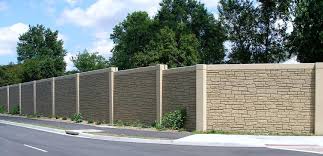You can tell when any design for a construction project is nearing completion by the topics of debate and discussion. When building a house, the discussion might be about the trim paint around the front door, when decorating a room, it would the style and color of the drapery, and with the Thruway it’s the pattern and exact color of the noise barriers.
Once installed, highway sound barriers, typically referred to as noise walls, are important in keeping offensive freeway sounds from penetrating local neighborhoods and business districts. Standing on the inside, the side facing away from traffic, it would be very easy to not be aware of the major roadway just feet away.
Giving the residents who will be most impacted by the Thruway’s construction, the decision power on the final noise walls looks and color is an excellent move on PennDOT’s part. No one enjoys a major construction project being built adjacent to their property and these barriers go a long way in mitigating the any potential negative impact of this much needed and long-awaited project.
Study after study has shown that these barriers reduce the amount of highway noise which in turn decreases health effects such as fewer headaches and hearing issues, generally better rest, and they even result in productivity improvement for at-home workers. Many folks adapt their backyard landscaping to conceal the walls or even to compliment walls’ simulated finishes.
Please read on for a column written by Justin Strawser which appeared in Saturday’s The Daily Item. Justin does a fantastic job, month after month, reporting on your Chamber’s Transportation Committee and its work alongside PennDOT.
PennDOT plans noise barriers for areas near CSVT section
Proposal IDs five neighborhoods
By Justin Strawser
jstrawser@dailyitem.com
PennDOT identified five neighborhoods where noise barriers for the southern section of the $900 million Central Susquehanna Valley Transportation Project are “warranted, feasible and reasonable.”
On Friday via Zoom, Matt Beck, assistant plans engineer for PennDOT District 3-0, told members of the Greater Susquehanna Valley Chamber of Commerce Transport-ation Committee that information and data are put into a computer modeling software to evaluate noise impact on highways across the project.
“For these five neighborhoods, we invited property owners and residents who will receive measurable benefits of proposed noise walls at meetings in late August,” said Beck. “We explained in group settings the noise analysis process, covering it in more detail. We gave everyone an opportunity to review the existing and projected future noise levels.”
The information and data include the configuration of the new highway, topography of the surrounding area, projections of future traffic volumes and measurements of existing noise levels. The model projects what noise levels will be in the future, up to 20 years following the completion of the project, said Beck.
To be considered warranted, feasible, and reasonable, the future noise levels must exceed 66 decibels; it must be physically possible to construct a barrier with a noise level reduction of at least five decibels for the majority of impacted residents; and it must also be cost-effective, said Beck.
Identified areas
The five locations are along the northern end of the Selinsgrove bypass between its southbound lanes and South Old Trail; along CSVT’s northbound lanes near Park and Fisher roads; just south of 11th Avenue near the northbound off-ramps of the Route 61 connector in Shamokin Dam; on the opposite side of the Route 61 connector near Orchard Hills; and along CSVT’s southbound lanes in the northern part of the project between Granger’s Road and County Line Road, said Beck.
About one-third of the residents invited to the meetings attended. Those residents were asked to submit ballots by this week on whether they want the barriers and what texture and color they preferred, said Beck.
“Next week we’ll take a closer look at where that voting stands,” he said.
Only a handful of residents were against the walls. There will likely be another round of outreach to ensure Penn-DOT did their due diligence in reaching those impacted, said Beck.
Shamokin Dam Mayor Joseph McGranaghan, who also chairs the transportation committee, said he has been encouraging residents to provide feedback to PennDOT.
Beck said if the feedback is conflicting, PennDOT will base its decision on the majority preferences.
Contracts
In June, Trumbull Corporation, of Pittsburgh, was awarded the first contract of three for the southern section at a low bid of $115.2 million. This contract is for earthwork for the roughly six miles of new four lane, limited access highway in Shamokin Dam and Monroe Township. Noise walls, as well as nine new bridges, will be included in the second contract for the southern section. The third construction contract is for highway paving.
Part of the northern section and the new river bridge opened earlier this summer. The last mile of the southbound portion is between 90 and 95 percent complete, Ted Deptula, the assistant construction engineer for PennDOT District 3-0.
“The end is in sight,” said Deptula.
The CSVT Southern Section will connect Routes 11-15 north of Selinsgrove to Route 15 and the northern part of the CSVT south of Winfield. The project will eventually include an interchange and connector to Routes 11-15 and Route 61 to the Veterans Memorial Bridge in Shamokin Dam.
© 2025 Greater Susquehanna Valley Chamber of Commerce, Inc. All rights reserved.
Website by MoJo Active



